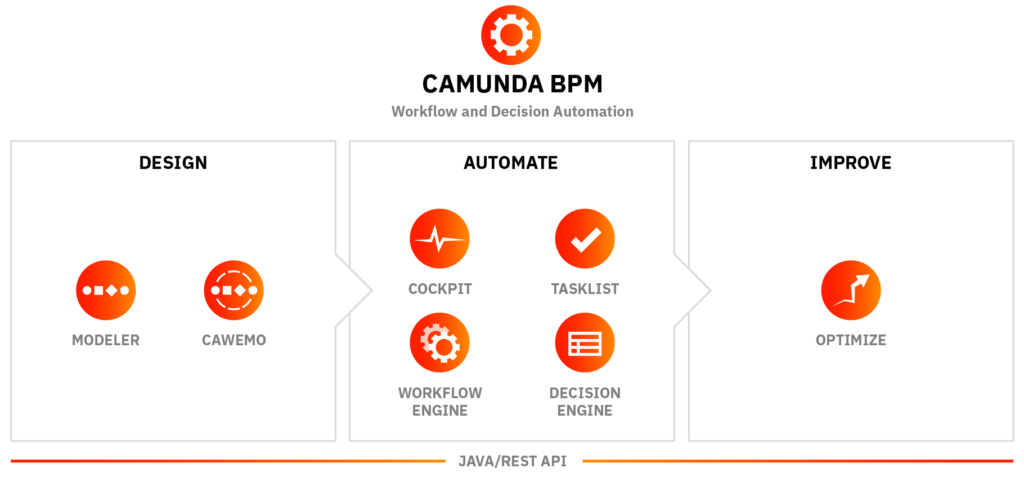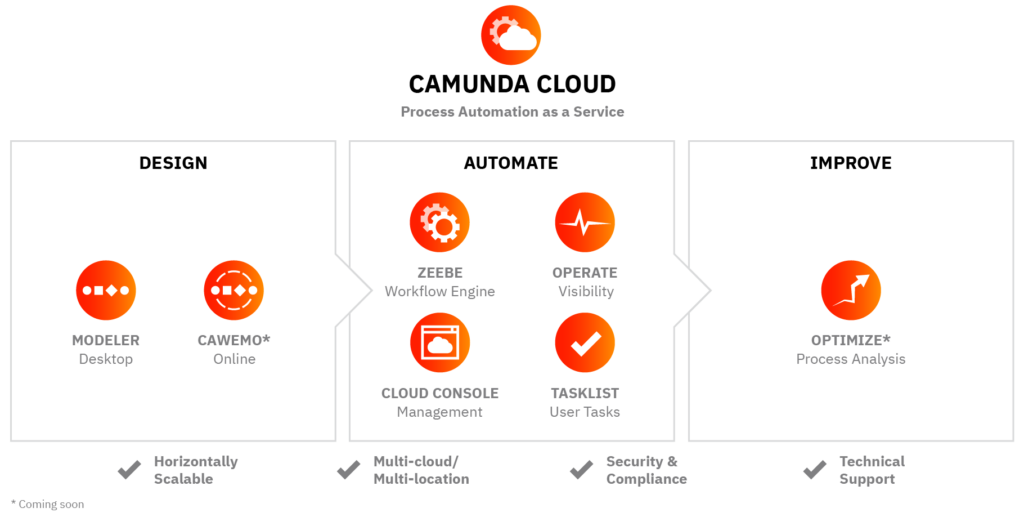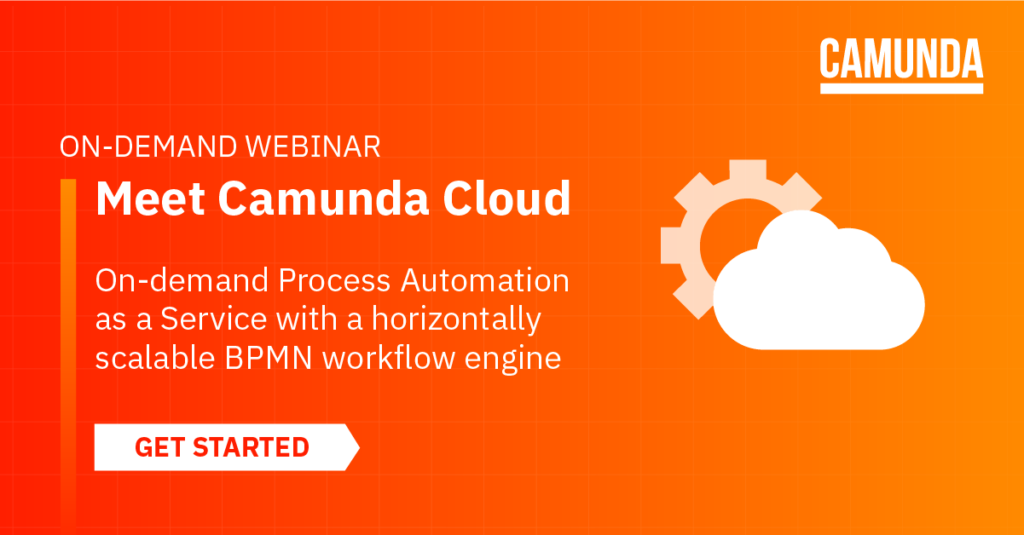You may have seen an explosion of information about Camunda Cloud over the past few weeks, whether here on the Camunda blog, or watching conversations unfold on Twitter. What is Camunda Cloud, and why is the community so excited about the first ever on-demand SaaS process automation as a service?
Camunda Cloud is a fully-managed enterprise SaaS for end-to-end Process Automation, built from the ground up for the cloud. It is based on the ISO standard BPMN and includes a horizontally scalable workflow engine along with built-in components for collaborative modeling, operations, and analytics.
In May we made Camunda Cloud generally available (GA), after an extensive public beta period and an early access program, which enabled us to gather significant input from customers who have deployed the service in production environments.
Our recent webinar: Introducing Camunda Cloud, walks through the features of Camunda Cloud, including a demonstration by Director of Engineering Sebastien Menski, using Java and the Spring Boot starter.
The webinar generated a number of questions about our latest release, so we’ve set out to answer them here:
Q&A
Camunda Cloud Vs Camunda Platform
Q: What’s the difference between Camunda Cloud and Camunda Platform?
A: Camunda Platform delivers full process automation for enterprise deployments across a wide variety of use cases and technologies.
Camunda Cloud is a SaaS-based solution for process automation.
Under the hood, Camunda Cloud is different to Camunda Platform, and this is down to the Zeebe workflow engine that powers Camunda Cloud. The biggest difference is that there is no single database — everything is sharded and replication is between brokers.
Zeebe is scaled by partitions, thus enabling horizontal scalability and ensuring there is no single point of failure.
Camunda Cloud also separates runtime from history. Runtime data is pushed out of a cluster to a data lake (Elastic Search), which can then be used by other applications to show different views of data.
On a high level, when we look at the differences between Camunda Platform and Camunda Cloud, there are certain components not yet available in Camunda Cloud, for example, Optimize and Cawemo — but the integration is coming soon.
Camunda Platform

Camunda Cloud

Q: Has Zeebe been renamed as Camunda Cloud?
A: No, Zeebe hasn’t been renamed. Zeebe is a critical component and the workflow engine that powers Camunda Cloud. Zeebe is also source-available and can be downloaded and used as a stand-alone workflow engine.
Q: Will Camunda Cloud replace Camunda Platform?
A: No. We have a comprehensive roadmap for both Camunda Platform and Camunda Cloud and will continue to support, maintain and develop both products for the foreseeable future (at least the next five years).
Q: Are discounts available for not-for-profit organizations?
A: The Camunda for Common Good program supports qualified NGOs and non-profit organizations that are making the world a better place. You can find more information and apply to the program here: https://camunda.com/common-good/
Q: What’s the best way to try out Camunda Cloud?
A: The best way to try Camunda Cloud is by signing up for a free trial.
Q: What are the usage limits in the various tiers?
A:
- Free plan: All Camunda Cloud features, limited to 30 days
- Professional Plan: Please visit frequently asked questions
- Enterprise Plan: Customizable to your needs — please contact us
Technical Capabilities and Features
Q: We are a .net shop, can I use Camunda Cloud with .net?
A: Yes of course. You can use gRPC to create new Clients for Camunda Cloud and there’s a Community project which you can use: https://github.com/camunda-community-hub/zeebe-client-csharp
Q: Could I use my own Tasklist or integrate user tasks directly instead of using what you provide out-of-the box?
A: Yes, you can interact with the Tasklist API to create your own Tasklist.
Q: How can I combine a rules engine with processes in Camunda Cloud?
A: We will provide a tighter integration with a DMN engine in the future. At the moment the best idea is to evaluate decision tables (or connect to other rules engines) as part of a worker that you implement. One example of DMN can be seen here: https://github.com/camunda-community-hub/zeebe-dmn-worker
Q: Where do I start when creating a Python client for Camunda Cloud? Is there an interface specification that I can use?
A: Creating new clients is relatively simple. We have an in-depth guide for creating new clients for Camunda Cloud and even for Python.
Q: Is process variable data secured, so it is not seen by other cloud customers?
A: In Camunda Cloud we run completely separated clusters for every customer, so that data will be completely separated.
Q: How do you deal with multi-tenancy? We do not want our processes (definition and operational data) or our data to be visible to others.
A: Like we mentioned above, we run completely separated clusters for every customer, so that data will be completely separated.
Q: Can DMN decision tables be executed on Camunda Cloud?
A: Yes, you can use workers, for example Java clients, to connect to any decision engine that executes DMN. There is a community project for evaluating DMN decision tables — you can find more on the Community Hub. There will be additional DMN functionality built into Camunda Cloud as we deliver more roadmap items.
Q: Is there only a Java starter kit, or are there any plans for other languages? Will Node js external task client work with Camunda Cloud?
A: Using Camunda Cloud should feel like home for you — it’s our goal to improve developer productivity and provide developers with the right tools, no matter which language you’re using. Camunda Cloud runs on Kubernetes and Zeebe clusters expose a GRPC gateway to the user — so it’s easy to create new clients in specific languages. We provide Java and Go out-of-the-box and there a number of community extensions available in languages including Rust and C#. If your preferred language isn’t there, it’s easy to contribute back to the community with an extension.
Q: Can I integrate my cockpit with LDAP integration for easy access?
A: Camunda Cloud provides a tool called Operate which is used for similar purpose as Cockpit (which you may know from Camunda Platform). In the self-managed version of Camunda Cloud you can integrate Operate with LDAP: https://docs.camunda.io/docs/self-managed/operate-deployment/authentication/#ldap

